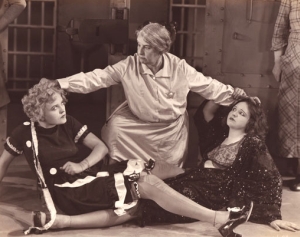
An Accomplished Australian
May Robson is a name familiar to any film buff worth his or her salt. It was a name which became commonly seen as the credits rolled on many great silent and sound films which have endured, and are still appreciated by viewers today. What is not as commonly known about this fine character actress, is that she was not only Australian, but also the earliest-born actress to receive an Oscar nomination as well as an accomplished woman in all other aspects of her life.
This is her story:
Jeanette Robinson was born in Melbourne, Australia, in 1858, moving to the United States in her teens and educated in Brussels, Paris and London. This privileged upbringing no doubt laid the foundation for her successful career as an actress in later life when she was forced to earn a living after the death of her husband.
Married to Edward Gore at the age of 22, the couple already had three children when Edward suddenly died after only three years of marriage. Struggling to support three small children, Mary found work as a tailor or seamstress, as well as a jewellery designer, which brought her in contact with the theatre.
She had no intentions of becoming an actress, but the need to earn money as a single mother prompted her to pursue any and all possibilities, and soon she was working both as an accomplished interpreter, due to her education in Europe, as well as an actress on stage. In the following years she flourished on the Broadway stage alongside other successful theatre performers who later made the transition to moving pictures, such as Douglas Fairbanks, Sr, to name just one.
Although she re-married in 1889, her acting career had taken off, and there was no stopping May Robson - as she was then known on stage. She played both leading and minor roles in theatre productions in New York at a time when moving pictures had not yet been invented.
Motion pictures was only an entertaining novelty in 1896, when Mary was already 38 years old, and the early 1900s saw the development of ‘the narrative film’ – a short film with a story, often only five to ten minutes in length. The camera stood stationary as it filmed actors and action, and there were no close-ups or different angles, and only basic editing and a few title cards to help explain the story.
The year 1912 officially marked the debut of the feature-length film, usually accompanied by more sophisticated editing and varied scenes, including close-ups. The year Douglas Fairbanks was enticed to make the transition to moving pictures, Mary also made her film debut with A Night Out, made in 1915. It was a comedy based on a play, and at the age of 57, she played ‘the granmum’.
Usually cast as someone's mother or grandmother, often as a somewhat rough personality, she sparkled opposite some of Hollywood's finest, such as Marguerite De La Motte in Pals in Paradise (1926); Bessie Love and Harrison Ford in the cross-country comedy, Rubber Tires, among the huge cast of Cecil B DeMille’s epic King of Kings (1927) depicting the life and death of Jesus Christ, and with Harrison Ford and Phyllis Haver in the comedy, The Rejuvenation of Aunt Mary in which she played the lead role.
May also appeared as Big Bertha alongside big silent screen stars, Leatrice Joy and Victor Varconi in Lois Weber’s The Angel of Broadway in 1927, and a year later again with Leatrice Joy and also Nils Aster in The Blue Danube.
Today, her best-known silent film role is that of Mrs Morton the matron, in the 1927 production of Chicago, starring the fabulous Phyllis Haver. This is largely due to the wonderful restoration of this great film which has been made famous over the decades in remakes such as Roxie Hart with Ginger Rogers and more recently the musical starring Renee Zellweger.
May Robson made a successful transition to talkies, which were officially inaugurated in 1929, and she went on to make 45 films during the 1930s.
Some of her other memorable roles during the sound era were opposite names like Norma Shearer in Strange Interlude, Jean Harlow in Dinner at Eight, Red-Headed Woman, Reckless and Wife vs. Secretary, Greta Garbo in Anna Karenina, Katherine Hepburn in Bringing Up Baby, and Janet Gaynor in A Star is Born. The list of leading men in films she appeared in included Clark Gable, Cary Grant, William Powell, and John Garfield.
But it was director Frank Capra, a name known to every film buff, who gave May Robson her shining moment in her Oscar-nominated role as Apple Annie, in his sentimental classic, Lady For a Day. May was 75 years old at the time, and was the first Australian-born person to be nominated for an acting Oscar, and for many years she also held the record for the oldest performer nominated for an Oscar.
These terrific and fondly remembered films benefited greatly from May Robson's fine characterizations, and therefore each of these Hollywood classics, including her silent films has an Australian connection as well.
In conclusion:
May Robson appeared in more than 60 films, the final one released after her passing at the age of 84. The release of the original Chicago is a nice way for Australians to remember and celebrate her career, and see for themselves how important Australian stars were to Hollywood's great success.
Details: Date of Birth: 19 April, 1858, and date of death: 20 October, 1942 in Beverley Hills, California, of natural causes. She is buried in Flushing Cemetery in Queens, New York City.
She stood only 5’2”, or 157cm.
